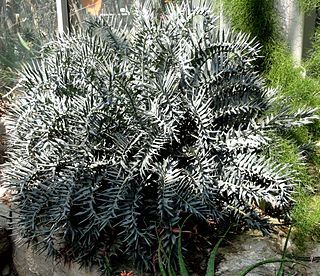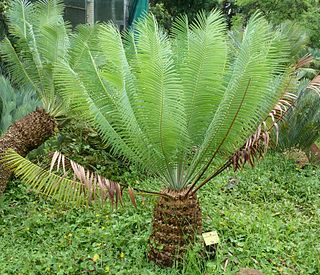
Encephalartos woodii, Wood's cycad, is a rare cycad in the genus Encephalartos, and is endemic to the oNgoye Forest of KwaZulu-Natal, South Africa. It is one of the rarest plants in the world, being extinct in the wild with all specimens being clones of the type. The specific and common name both honour John Medley Wood, curator of the Durban Botanic Garden and director of the Natal Government Herbarium of South Africa, who discovered the plant in 1895.

Encephalartos horridus, the Eastern Cape blue cycad, is a small, low-growing cycad up to 0.9 m (3.0 ft) high and 0.9 m (3.0 ft) wide. It is a native of Eastern Cape Province, South Africa, and found in arid shrublands, most commonly on ridges and slopes with shallow soils. The species is particularly known for its distinctly blue-gray leaves, although the degree of coloration can vary significantly. The species name horridus is Latin for 'bristly', after the plant's stiff, spiny leaflets.

Encephalartos altensteinii is a palm-like cycad in the family Zamiaceae. It is endemic to South Africa. The species name altensteinii commemorates Altenstein, a 19th-century German chancellor and patron of science. It is commonly known as the breadtree, broodboom, Eastern Cape giant cycad or uJobane (Zulu). It is listed as vulnerable due to habitat destruction, use for traditional medicine and removal by collectors.

Encephalartos lebomboensis is a species of cycad in the family Zamiaceae. Native to the Lebombo Mountains of South Africa, the species was first described in 1949 by the South African botanist Inez Verdoorn. It is commonly known as the Lebombo cycad, although the name is also used for Encephalartos senticosus which also occurs in the same locality.

Encephalartos whitelockii is a species of cycad that is native to Uganda.

Encephalartos turneri is a species of cycad that is native to Mozambique. The Encephalartos turneri was discovered by Ian Sutherland Turner in Nampula, Mozambique.

Encephalartos trispinosus is a species of cycad that is native to the Eastern Cape Province of South Africa.

Encephalartos natalensis, the Natal cycad or giant cycad, is a species of cycad that is endemic to the Qumbu and Tabankulu areas of the northern part of the Eastern Cape, and through most of KwaZulu-Natal. The number of mature individuals of this species is declining and the International Union for Conservation of Nature has assessed its conservation status as being "near threatened".

Encephalartos eugene-maraisii is a species of cycad in the family Zamiaceae. It is endemic to South Africa, where it is limited to Limpopo. It is known as the Waterberg cycad.

Encephalartos dolomiticus, the Wolkberg cycad, is a critically endangered species of cycad. It is only found in the Wolkberg at elevations of 1100–1500 meters. The area is near Penge in southeastern Limpopo Province, South Africa.

Encephalartos barteri is a species of cycad that is native to Benin, Ghana, Nigeria, and Togo.

Encephalartos middelburgensis is a species of cycad that is native to Gauteng and Mpumalanga provinces of South Africa at elevations of 1,100–1,400 m (3,600–4,600 ft).

Encephalartos manikensis is a species of cycad that is native to Mozambique and Zimbabwe.

Encephalartos kisambo is a species of cycad in the family Zamiaceae. It is known as the Voi cycad.

Encephalartos inopinus is a species of cycad that is native to Limpopo Province, South Africa.

Encephalartos hildebrandtii is a species of cycad in the Zamiaceae family. It is native to Kenya and Tanzania at elevations from sea level to 600 metres (2,000 ft). The species is named for the German explorer Johann Maria Hildebrandt.
Encephalartos schmitzii is a species of cycad in Africa.
Encephalartos poggei is a species of cycad in the family Zamiaceae. It is referred to by the common name Kananga cycad. It is native to Angola, the Democratic Republic of the Congo and Zaire.
Encephalartos macrostrobilus is a species of cycad in Africa. It is found only in Moyo District, northwestern Uganda, which is populated predominantly by the ethnic Madi.
Encephalartos heenanii is a species of cycad in Southern Transvaal Province, South Africa.

















